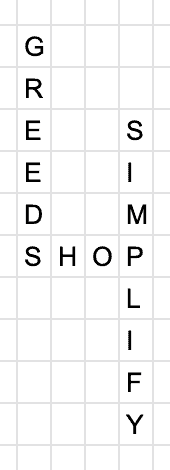1. 简介
生成填字游戏(Crossword Puzzle)的核心目标是将一组单词合理地放置在一个网格中,使得这些单词可以交叉排列。本文将介绍几种生成填字游戏的算法,重点在于如何选择单词的放置位置,以构建出高质量的填字游戏。
2. 逐词放置算法
2.1. 算法原理
该算法的基本思路是将单词逐个放置到网格中,直到放置的单词数量达到上限或没有单词可放为止。具体步骤如下:
- 随机打乱单词列表;
- 放置第一个单词在网格中央;
- 对于后续每个单词,尝试将其每一个字母与网格中已有的字母匹配;
- 若匹配成功,则尝试放置该单词并检查是否合法;
- 若合法,则放置该单词并继续处理下一个单词;
- 若所有尝试都不合法或没有匹配项,则跳过该单词。
伪代码如下:
algorithm IterativePlacement(words, maxWords):
shuffle(words)
word <- pop(words)
crossword <- place(word, null, 0, 0, HORIZONTAL)
count <- 1
while count < maxWords and len(words) > 0:
word <- pop(words)
for letter in word:
for y in rows(crossword):
for x in cols(crossword):
if crossword[y, x] = letter:
placement, ok <- canPlace(word, crossword, x, y)
if ok:
crossword <- place(word, crossword, placement.x,
placement.y, placement.direction)
count <- count + 1
continue
return crossword
这个算法的实现中,place() 和 canPlace() 是关键函数,但未在伪代码中展开。它们分别用于将单词放置到指定位置,并判断该位置是否合法。
2.2. 示例演示
我们以单词 SHOP 作为第一个单词放置,初始结果如下:

接着尝试放置 GREEDS,发现其最后一个字母 S 与 SHOP 的首字母匹配,成功放置:

继续尝试 FAINT,由于无匹配字母,跳过。
再尝试 SIMPLIFY,其字母 P 与 SHOP 中的 P 匹配,放置成功:

最终生成完整填字游戏如下:

✅ 优点:实现简单,适合快速生成初版填字游戏
❌ 缺点:随机性强,结果可能不够紧凑、美观
3. 多次生成择优算法
3.1. 算法原理
为了提升填字游戏质量,我们可以生成多个网格,然后从中选择得分最高的一个。该算法的伪代码如下:
algorithm RepeatedGeneration(words, maxWords, iterations):
maxScore <- 0
result <- null
for i <- 0 to iterations:
crossword <- generate(words, maxWords)
score <- generateScore(crossword)
if score > maxScore:
maxScore <- score
result <- crossword
return result
我们可以根据设定的迭代次数生成多个填字游戏,并根据评分函数选择最优解。
3.2. 评分函数设计
评分函数是决定“最优”的关键。常见的评分维度包括:
- 填充率:填充的格子越多,得分越高;
- 网格比例:越接近正方形得分越高;
- 单词平均长度:可根据偏好选择长词或短词。
一个示例评分函数如下:
algorithm GenerateScore(crossword):
sizeRatio <- rows(crossword) / cols(crossword)
if rows(crossword) > cols(crossword):
sizeRatio <- cols(crossword) / rows(crossword)
filled <- 0
empty <- 0
for y in rows(crossword):
for x in cols(crossword):
if crossword[y, x] = null:
empty <- empty + 1
else:
filled <- filled + 1
filledRatio <- filled / empty
return (sizeRatio * 10) + (filledRatio * 20)
假设我们有两个网格,第一个得分 21.93,第二个得分 12.37,则选择第一个。
⚠️ 注意:评分函数需根据实际需求调整,不同评分标准会显著影响最终结果。
4. 多路径择优放置算法
4.1. 算法原理
之前的算法在找到第一个可放置位置后就直接放置单词,可能导致后续单词难以插入。为了解决这个问题,我们可以:
- 对当前单词尝试所有可能的放置位置;
- 对每个位置生成一个新网格并打分;
- 选择得分最高的那个作为最终放置结果。
伪代码如下:
algorithm RepeatedWordPlacement(words, maxWords):
shuffle(words)
word <- pop(words)
crossword <- place(word, null, 0, 0, HORIZONTAL)
count <- 1
while count < maxWords and len(words) > 0:
word <- pop(words)
placements <- [ ]
for letter in word:
for y in rows(crossword):
for x in cols(crossword):
if crossword[y, x] = letter:
placements <- append(placements, findPlacement(word, crossword, x, y))
bestScore <- 0
bestBoard <- crossword
for placement in placements:
newBoard <- place(word, crossword, placement.x, placement.y, placement.direction)
newScore <- generateScore(newBoard)
if newScore > bestScore:
bestScore <- newScore
bestBoard <- newBoard
if bestScore > 0:
crossword <- bestBoard
count <- count + 1
return crossword
4.2. 进一步优化
虽然该算法每次选择最优放置位置,但仍可能因局部最优导致整体结果不佳。例如,某次放置虽然当前最优,但限制了后续单词的插入。
为解决这一问题,可以构建一个“深度优先”的搜索树,尝试所有可能的路径,直到一定深度,然后选择最终得分最高的路径。这类似于经典的搜索算法(如 DFS、A* 等),适用于对结果质量要求较高的场景。
✅ 优点:生成结果更紧凑、美观
❌ 缺点:计算复杂度高,适合离线生成
5. 总结
本文介绍了三种生成填字游戏的算法:
| 算法名称 | 特点 | 适用场景 |
|---|---|---|
| 逐词放置 | 简单易实现,速度快 | 快速原型、轻量应用 |
| 多次生成择优 | 多次生成取最优,结果更佳 | 对质量有一定要求的场景 |
| 多路径择优放置 | 每次选择最优路径,结果最优 | 高质量填字游戏生成 |
未来可以尝试实现深度搜索算法,进一步提升生成质量。如果你对这个方向感兴趣,不妨动手实现一个完整的填字游戏生成器试试看。